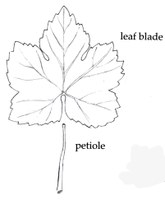July is Grape Petiole Sampling Time
Soil samples do not adequately reflect the nutritional needs of perennial woody species, but tissue testing can accurately assess a grapevine’s nutrient status and serve as a guideline for supplementary fertilization. Well‐planned and consistent petiole sampling will yield important vine nutrition information for the grower. This information along with proper timing of application can maximize fertilizer use efficiency, vine performance, protect the environment, and maximize profit. This service is available through the OSU County Extension Centers across Oklahoma. Visit the OSU County Extension Offices page to find your local office.
To ensure accurate results, the following instructions should be followed: 
- Collect Petiole samples at veraison or berry coloring which usually occurs in July.
- Sample should be uniform. Different cultivars, rootstocks, soil types, and management practices should be sampled separately.
- Should be representative of vineyard but not represent more than 10 acres.
- Collect 100 petioles for each sample.
- Select from vines in a pattern (i.e. every 10th vine in every 5th row, etc.). Sample from same vines annually.
- Petiole should come from the youngest fully mature leaf near the shoot apex (usually about 6 or 7 leaves from the end).
- Remove leaf blade and discard, place the petiole in a clean labeled paper
 sack (don't put fresh sample in sealed plastic bags since it will break down during
shipping.)
sack (don't put fresh sample in sealed plastic bags since it will break down during
shipping.) - Record information regarding the sample for identification and later interpretation.
- Petiole samples should be taken to the county extension office as soon as possible.
Samples will be sent to the OSU Soils, Water, and Forage Analytical Laboratory for analysis. The fee for each sample is $20 which includes N, P, K, Ca, Mg, S, B, Cu, Fe, Zn, and Mn. Results of analysis will be returned to the extension office for nutrient recommendations.
Critical values for nutritional status of grapevines were primarily developed from ‘Concord’ – other cultivars may have other nutritional requirements. Application of certain fungicides and nutrient sprays can influence petiole sample results, so collection after rainfall or washing with distilled water may help. Fertilizer recommendations for grapes have not been researched in Oklahoma vineyards. Use visual inspections to evaluate the vines along with recommendations to tailor fertilizer programs.
